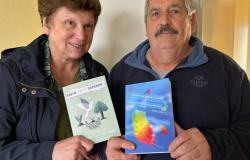CRITICAL – After years of separation, a father reunites with his daughter. History of a rebirth and meditation on the power of art.
On a Tuesday in October, at 5 p.m. on the island of Naoshima, Japan, the factory siren sounded. The Masao worker leaves his workstation after storing the part he is working on and carrying out the usual checks. He leaves. In the sea he feels currents “contradictory and violent”. The sun is already low on the horizon. In the distance, he notices an unusual silhouette. Something in his posture, a presence, a lightness, is familiar to him. She approaches. It’s her. His daughter, Harumi, from whom he had not heard from for fourteen years. She places her temple on her father’s shoulder for a long time, then stands up; smiles, takes his hands in his: striking contrast between his soft skin and the calloused fingers of the worker. Her hair flutters in the breeze. Everything is airy about this young woman, calm. Yes, what a contrast.
As you can imagine, the girl has many questions to ask her father. But Masao is not ready to go back to the events that led to their separation. No matter, Harumi is patient. Nothing by force, everything by gentleness. Their reunion will stretch throughout the months of autumn and winter, the time that the young architect will spend on the neighboring island of Teshima. She came there to work on a monumental artistic project, a museum where nothing will be exhibited, which will be the work itself.
Also read“Marilyn? An exhibitionist without dignity, ready to do anything to succeed!”: in The Enchanters, James Ellroy torpedoes the absolute female icon
Readers who do not know the gem of contemporary artist Rei Naito will have to wait until the decisive penultimate chapter to learn more about this work of art. Decisive because it is when Masao visits it with his daughter, before the inauguration, that he will finally be able to expel the black waters, sadness and shame, in which he had been internally stuck for almost thirty years. And it is thus, in the renewed inner silence, that speech will come to him and that he will be able to tell his daughter what happened to her mother.
Humility and righteousness
Through the story of this profoundly just and good man, whose life was devastated by a tragedy, Antoine Choplin, 62 years old, experienced writer, engaged in multiple cultural activities, questions what art is. and about what art does. Are art and literature elitist? Can they touch a worker like Masao, touch him to the point of working in him? And the boat that Masao had made with his own hands, piece by piece, in maritime pine wood, in a garage that had been lent to him, is it a piece of art? In any case, it is this little boat, so frail in the face of the elements, that will restore his pride, put him back on his feet facing his daughter in the golden light of a March dawn.
When he was a lighthouse keeper, at the darkest point of his life, alone and surrounded by the waves, Masao was offered a volume by Hölderlin, a single book, reread constantly, which was the companion of his winters. He loved these poems and the two words with which the author often signs them: “With humility.” Humility and righteousness, we want to say that it is the interior posture of this story, its ethics, which translates into a certain way of telling, very simple, which lets in as much light and silence as possible between the words. . As if the literary narrative, and any work of art, should not compete with the world, but create within it a space for breathing and contemplation.
» Follow all the news from Figaro culture on Facebook et Twitter .
» Find our literature section on Le Figaro Store .






